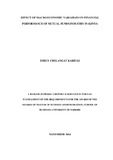| dc.description.abstract | The financial sector today is an important part of the social infrastructure. For a long time, mutual fund investment has played an important role in the financial market and its popularity has increased dramatically over the past decade. Mutual funds are managed pools of financial assets that can be invested in by retail or institutional investors. The mutual fund industry in Kenya is very young having started with the passage of the Capital Markets Amendment Act (2000), which recognizes specific investment vehicles and especially mutual funds. The continued poor performance of mutual funds in the presence of increased investments in intellectual assets raises questions on the substance of macroeconomic variables in addressing the challenges facing the mutual funds in Kenya. Unimpressive mutual funds are therefore facing competition from newer alternatives, including exchange-traded funds (ETFs), folios and separately managed accounts. These alternatives offer certain advantages over mutual funds. The study sought to establish the effect of macroeconomic variables on financial performance of mutual funds industry in Kenya. This study took a causal research design approach. The study solely used annual report data sources available at the companies‟ books of account, Kenya national bureau of statistics and the NSE or Capital Market Authority offices. The study used data analysis software such as, Microsoft Excel and SPSS version 21 to analyse the data. The study used multiple linear regression equation and the method of estimation was Ordinary Least Squares (OLS) so as to establish the relationship between macroeconomic variables and mutual fund performance. The analyses entailed the computation of the various coefficients of the independent variables correlated against the ROI. The macroeconomic variables coefficients are denoted as “β” in the model. Regression was employed to examine the effect of selected determinant variables on the performance of mutual firms. From the regression model, the study found out that there were macroeconomic variables influencing fund performance among mutual funds operating in Kenya with equity portfolios licensed by the Capital Markets Authority, which are money supply, interest rate, inflation rate, GDP and exchange rates. They either influenced it positively or negatively. The study found out that the intercept was 0.478 for all years. The five independent variables that were studied (money supply, interest rate, inflation rate, GDP and exchange rates) explain a substantial 70.9% of fund performance among mutual funds operating in Kenya with equity portfolios licensed by the Capital Markets Authority as represented by adjusted R2 (0.709). The study concluded that money supply, interest rate, inflation rate and GDP positively and significantly influence fund performance among mutual funds operating in Kenya with equity portfolios licensed by the Capital Markets Authority while exchange rate negatively but significantly influence fund performance among mutual funds operating in Kenya with equity portfolios licensed by the Capital Markets Authority | en_US |

